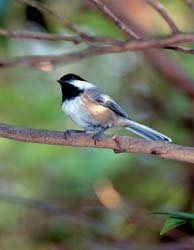
Wild About Nature? Get Your Yard Certified
The North American bird population has decreased by 2.9 billion breeding adults, a net loss of 29% over the last half-century. Scientists have identified habitat loss as the biggest reason for the decline. Wild Birds Unlimited is proud to be the Champion for the National Wildlife Federation (NWF) Habitat Program, whose goal is to inspire everyone to create a haven for wildlife in their yard.
Anyone can create a welcoming haven for local wildlife. In fact, wildlife habitat gardens support twice as much wildlife as conventional lawns and non-native plant gardens. Turning your yard, balcony container garden or work landscape into a Certified Wildlife Habitat to attract birds, butterflies, and other neighborhood wildlife is fun, easy, and can make a lasting difference. Here is what your wildlife habitat should include:
Creating a bird-friendly habitat requires four elements – food, water, shelter and a place to raise young.
1. Food
You can attract a greater number and variety of birds by offering a consistent, reliable supplemental food source in the form of a bird feeder filled with a quality seed blend. Creating a bird feeding station with a variety of foods and various bird feeders will bring you many hours of bird watching to enjoy. Learn more about the variety of bird food available at WBU, click here.
2. Water
Water can attract as many birds to your yard or patio as a food. Often, you will attract birds that do not normally visit your bird feeders. Learn more about the variety of ways you can offer water in your wildlife friendly habitat, click here.
3. Cover
Birds need protective cover for times of rest, social interaction and as a retreat from foul weather and predators. Landscaping for the ideal wildlife habitat should use native plants ranging in size and density.
4. A Place to Raise Young
The same native plants that provide food and shelter can provide safe areas for many species of wildlife to mate, build nests and raise their families. But, with the increased loss of natural habitat, many cavity-nesting birds are having trouble finding homes. By providing bird houses, you will encourage birds to raise their young in your yard.
Sustainable Practices
The idea of a flawless lawn may be a thing of the past. A few weeds and insects are a small price to pay for better health for people and the environment. Maintaining your landscape in a sustainable, environmentally-friendly way ensures that the soil, air, and water that native wildlife (and people) rely upon stay clean and healthy.
Visit the National Wildlife Federation (NWF) site to learn more about creating a Certified Wildlife Habitat. There is a small application fee that will help the NWF in their efforts to protect wildlife and habitats. You will receive a certificate and have an opportunity to buy a sign or plaque to display in your habitat. Certify Your Backyard Here
The Certified Bird Feeding Specialists at Wild Birds Unlimited are ready to help you get started. Visit your local Wild Birds Unlimited for more information and resources.

